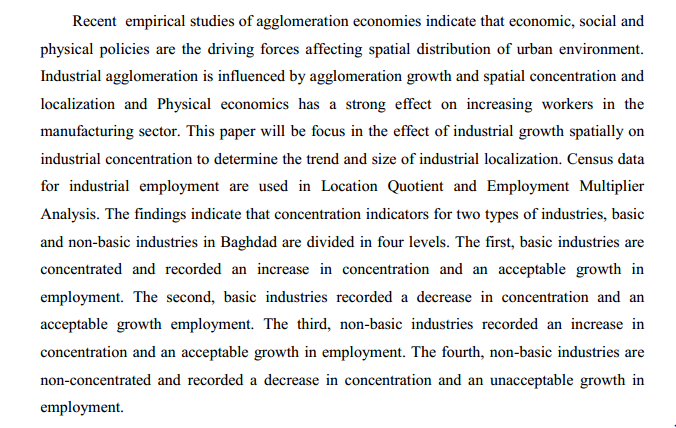 (5)
(5)
 (4)
(4)
 (3)
(3)
Limitations of the conventional diagnostic techniques urged researchers to seek novel methods to predict, diagnose, and monitor periodontal disease. Use of the biomarkers available in oral fluids could be a revolutionary surrogate for the manual probing/diagnostic radiograph. Several salivary biomarkers have the potential to accurately discriminate periodontal health and disease. This study aimed to determine the diagnostic sensitivity and specificity of salivary interleukin (IL)‐17, receptor activator of nuclear factor‐κB ligand (RANKL), osteoprotegerin (OPG), RANKL/OPG for differentiating (1) periodontal health from disease and (2) stable a
... Show More (11)
(11)
 (9)
(9)
A field experiment was conducted during winter, 2015-16 with the objective to investigate the effect of bread wheat cultivars (Abu-Ghraib3, Ibaa99, and Alfeteh) and seed priming 100, 100, 150 mg L-1 of benzyl adenine, salicylic acid, gibberellic acid (GA3), respectively, ethanolic extract of Salix Sp., water extract of Glycyrrhiza glabra and distilled water (control) on grain growth rate (GGR), effective filling period (EFP) and accelerating of physiological maturity. Randomized complete block design with three replicates was applied. GA3×Ibaa99 surpassed others in grain yield (7.432 tonne ha-1) when gave the highest grain weight (45.13 mg grain-1) and GGR (1.5 mg grain-1 day-1) with the fastest time to start and end EFP (5 and 34 days), w
... Show More (6)
(6)
 (2)
(2)
Nitrogen (N) and phosphorus (P) are the most important nutrients for crop production. The N contributes to the structural component, generic, and metabolic compounds in a plant cell. N is mainly an essential part of chlorophyll, the compound in the plants that is responsible for photosynthesis process. The plant can get its available nitrogen from the soil by mineralizing organic materials, fixed-N by bacteria, and nitrogen can be released from plant as residue decay. Soil minerals do not release an enough amount of nitrogen to support plant; therefore, fertilizing is necessary for high production. Phosphorous contributes in the complex of the nucleic acid structure of plants. The nucleic acid is essential in protein synthesis regulation; t
... Show MoreBackground: Feeding is a complicated process that involves the coordination of cardiovascular, respiratory, gastrointestinal (GI), and oropharyngeal mechanisms, with support from the musculoskeletal and craniofacial systems. The practice of feeding could be correlated with eruption stage and nutritional status in infants. Aim of the study: This study aimed to assess the relation of feeding patterns to a selected oral variable (stage of the eruption of primary teeth) and growth parameters among clinically healthy infants. Subjects and Methods: A cross-sectional comparative study on a sample of (300) infants aged between 6 and 18 months was performed in Karbala City, Iraq. The feeding pattern was investigated using an information sheet ans
... Show MoreA. chroococcum isolate was examined for its ability to produce the hydrolytic enzymes chitinase, pectinase, protease, and lipase, in an effort to enhance the growth of fava bean (Vicia faba). Biological experiment was conducted in pots with complete random design (CRD). The experiment includes three treatments: control (plant without treatment) (P), NPK fertilizer (plant + fertilizer) (PF), and A. chroococcum inoculum (plant + A. chroococcum) (PA). These treatments were performed with sterile and non-sterile soil, which were planted with fava beans. At the end of experiment (seven weeks from planting), length and weight of plant shoot and plant root were calculated. The results show that the isolate wa
... Show More (6)
(6)
 (1)
(1)
A novel ligand, (E)-5-((2-hydroxy-4,6-dimethylphenyl)diazenyl)-2,3-dihydrophthalazine-1,4- dione, was synthesized through the reaction of 3,5-dimethylphenol with the diazonium salt of 5-amino-2,3-dihydrophthalazine-1,4-dione. The ligand underwent characterization through the utilization of diverse spectroscopic methods, including UV-Vis, FT-IR, 13C, and 1H-NMR, alongside Mass spectroscopy and micro elemental analysis (Carbon, Hydrogen, Nitrogen, and Oxygen). Metal chelates of transition metals were prepared and analyzed using elemental analysis, mass spectra, atomic absorption, UV-Vis, FT-IR spectral analysis, as well as conductivity and magnetic measurements. The investigation into the compounds’ nature was conducted by utilizing mole r
... Show More
